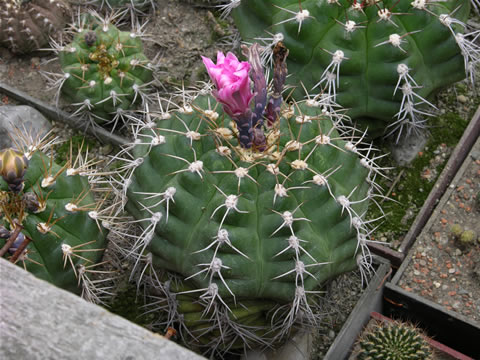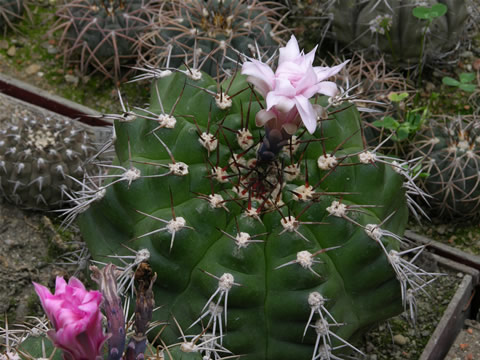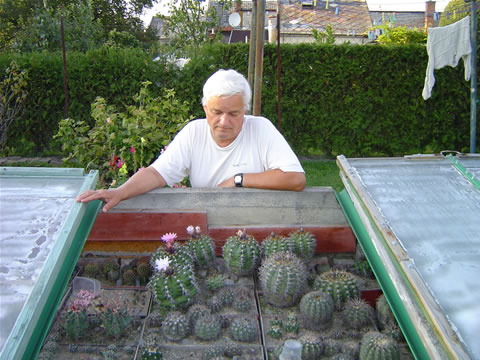Cactus (Francie) 95, 1963
Ploše kulovité, 2 – 4 cm vysoké, 6 – 9 cm široké, šedozelené. Žebra 6 – 7, hrbolcovitá, 5 mm vysoká, 2,5 cm dole široká, areoly vzdálené 1 – 2 cm, kulaté nebo oválné, 5 mm dlouhé, s bílošedou plstí.
Okrajové trny 6, ohnuté, 15 – 23 mm dlouhé. Střední nezřídka chybí. Všechny trny jehlovité, šedobílé, na špici nahnědlé.
Květy z prohloubeného temene, 4 – 6 cm dlouhé, nálevkovité, růžové. Ovarium kulaté, ohnuté, 5 mm v průměru, tmavě fialově červené, s 3 mm širokými načervenalými, bíle lemovanými šupinami. Trubka 2,5 cm dlouhá, fialově červená, s 5 mm širokými šupinami. Vnější okvětní lístky kopisťovité nebo kopinaté, 2 cm dlouhé, růžově červené. Vnitřní okvětní lístky 2,5 cm dlouhé, špičaté, šeříkově růžové, dole purpurově červené. Tyčinky 5 mm dlouhé. Nitky magentově červené; prašníky žluté. Čnělka 22 mm dlouhá, fialově červená, bliznové laloky 8, dlouhé 3 mm.
Plod eliptický, 2 cm dlouhý, zpočátku nahnědlý, později purpurově červený. Semena malá, 1 mm v průměru, světle hnědá, bradavčitá.
Překlad popisu z francouzštiny je skoro shodný.
Domovina: Bolívie, provincie Chiquitas, department Santa Cruz, blízko San José, 600 m n.m.
Původně se v literatuře uváděl jako nálezce páter Hammerschmid, představený kláštera, ten však obdržel rostliny od jiného pátera Klingera z téže misie. Hammerschmid poslal rosliny k posouzení prof. Cardenasovi a ten je pak popsal ve francouzském časopisu Cactus. Misie si přivydělala i nějaký ten peníz zasláním rostlin nasbíraných v okolí kláštera importérské firmě Karlheinz Uhlig v Rommelshausenu u Stuttgartu. Zde získal několik rostlin také Backeberg a jelikož šlo na první pohled o dosud neznámý taxon, popsal je jako Gymn. hammerschmidii. Tak je tato historie prezentována ve valné většině pojednání o Gymn. chiquitanum. Zůstane však již asi tajemstvím, zda pracovití mniši sbírali rostliny Gymn. chiquitanum poslané Cardenasovi na jednom místě, a pak našli podobné rostliny popsané později jako Gymn. hammerschmidii na místě jiném. Gymn. hammerschmidii je všemi odborníky posuzováno jako synonym Gymn. chiquitanum, ale to ještě nemusí být zcela jednoznačné.
Překlad popisu z francouzštiny je takřka totožný, zveřejněný ve francouzském časopisu Cactus, se kterým se lze u nás setkat jen ojediněle. Po popisu následuje obšírné srovnávání popisovaného taxonu Gymn. chiquitanum s ostatními členy rodu vyskytujících se v Bolívii, např. z podrodu Pirisemineum, a popis vegetace tamtéž. Jde o pohled prof. Cardenase se zřetelem výhradně k bolivijské floře se zkušenostmi odpovídajícími době popisu. Ostatní členové rodu Gymnocalycium za hranicemi Bolívie nejsou bráni v úvahu. Proto nepovažuji za užitečné napsat zde nějaký výtah z těchto komentářů, protože by dnešním gymnofilům asi nic neřekl. Pokud bude někdo chtít získat hodnotné informace o přírodních podmínkách nalezišť gymnokalycií, nechť si bedlivě prostuduje velmi zdařilou práci Detleva Metzinga, o které i pan Lukašík prohlásil, že je to to nejlepší, co o gymnech kdy četl.
Jako první po popisech obou taxonů pozoroval oba taxony páter Alfredo Lau roku 1970 a podal zprávy o variabilitě otrnění, jak v barevnosti, tak i síle. Květy popisuje jako neměnné světle růžově fialové s nádechem do oranžova s hluboce fialovou trubkou. Podle informací pátera Hammerschmida rostliny v přírodě dosahují až 15 cm v průměru a odnožují. To je možné potvrdit i z pěstování v kultuře, takových rozměrů dosahují rostliny roubované na Erioc. jusbertii. Nesmíme zapomenout, že taxon pochází ze subtropických oblastí, kde již rostou i palmy, a podle toho rostliny pěstovat. Pravokořenné rostliny při chladnu a mokrém substrátu zčervenají, scvrknou se, ztrácí kořeny bez valné naděje na jejich záchranu a posléze se loučí se svým nevděčným pěstitelem. Pokud chceme dosáhnou úspěchu bez rizika záhuby rostlin, je vhodné rostliny v pařeništi naroubovat, nebo je pěstovat ve vyšších policích skleníku při řádné zálivce a teplotu nenechat poklesnout pod 15°C.
Naleziště taxonu navštívil dr. Detlev Metzing z oldenburgské univerzity a zjistil, že jedinci rostou na vyvýšených remízcích, někteří jedinci mají trny žluté, někteří červené. Jde však o formy s promíchaným výskytem, není pravdou dříve uváděný názor, že sprašováním např. červenotrnných jedinců získáme výhradně červenotrnné potomstvo.
Další nálezy: KK 821 San José Santa Ana, KK 511 San José; LB 2315 65 km od San José; STO 931 San José Suia de San José; VoS 03-28 Serrania de Chiquitos.

Gymn. chiquitanum KK

Gymn. chiquitanum red spines

Pařeniště s Gymn. chiquitanum
Gymn. chiquitanum – summary:
There had been originally mentioned like the founder the father Hammerschmid in the literature, he had been the superior of the monastery, however, he had got the plants from another father Klinger of the same mission. Hammerschmid had sent the plants for the judgment to prof. Cardenas and then he has described them in the French journal Cactus. The mission had also gained some money by sending plants collected in the environment of the monastery to the importer firm of Karlheinz Uhlig in Rommelshausen near Stuttgart. Backeberg had got also several plants there and because it had been evident at the first sight it was unknown taxon at that time, he has described it like Gymn. hammerschmidii. This story is presented like this in the most articles about Gymn. chiquitanum. However, it will be probably the secret forever, if the painstakink fathers had collected the plants Gymn. chiquitanum sent to Cardenas at one place and then they had found similar plants described later like Gymn. hammerschmidii at another place. Gymn. hammerschmidii is appreciated by all specialists like the synonym of Gymn. chiquitanum but it need not be quite explicit else.
The translation of the description from the French language is nearly identical, published in the French journal Cactus which is possible to see in our country only little. Quite substantial comparison after the description of Gymn. chiquitanum follows with the other members of the genus occuring in Bolivia, for example from the subgenus Pirisemineum and the description of the vegetation there. It is the sight of prof. Cardenas with the regard only to the Bolivian flora and with the experiences of that time. The other members of the genus Gymnocalycium behind the frontier of Bolivia are not taken in any account. Therefore I think it is not useful to write here some report from these comments, because it would say to nowadays gymnofilf hardly anything. If somebody wants to get the valuable information as to the natural conditions of the finding places of gymnocalyciums we let him to study very good work of dr. Detlev Metzing about which even Mr. Lukašík has said that it has been the best what he has anytime read about gymnos.
The father Alfredo Lau observed both taxa like the first in 1970 after the descriptions and he has given the news about the variability of the spination both in the colour and in the strength. He has described the flowers like uniform light pink violett with orange tinge with dark violett tube. After the information of the father Hammerschmid the plants in the nature reach to 15 cm in diameter and they make offsprings. It is possible to agree with it also from the culture, the plants can reach these size if they are grafted on Eriocereus jusbertii. We must not forget that the taxon originates from the subtropic areas where the palms already grow and we must grow them after it. The plants on their own roots become red if it is cold and wet, they shrank, lost roots without some hope of their saving and then they part with their ungrateful grower. If we want to be succesful without the risk of the plant annihilation, it is good to graft them in hotbeds or to grow them in a greenhouse on the higher positions with proper watering and not to let to go the temperature under 15°C
Dr. Detlev Metzing from the University of oldenburg has visited the finding place of the taxon and he has found that the specimens grow on the higher little docks, some specimens have yellow spines, the other red ones. However, they are forms with mixed occuring and it is not right the older opinion that if we pollinate for example only red spined specimens we can get only red spined offspring.
